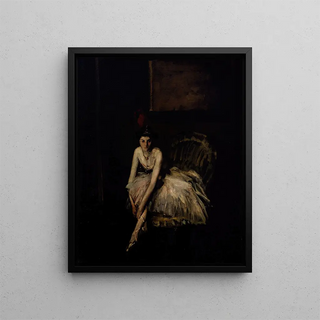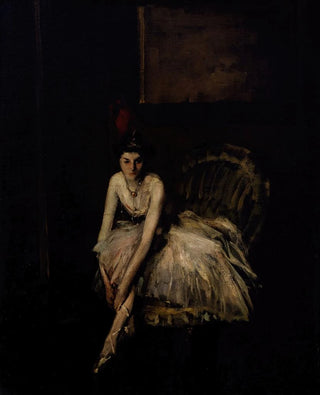Art print | Ballet dancer - Robert Henri


View from behind

Frame (optional)
In the fascinating world of art, some artworks manage to capture the very essence of a moment, an emotion, a life. "Ballet Dancer - Robert Henri" is one of those creations that transcend mere visuals to immerse the viewer in a world of grace and movement. This piece, imbued with dynamism and sensitivity, evokes the beauty of ballet, an art form that combines discipline and creativity. Henri, through this painting, invites us to feel the lightness and elegance of a dancer, while immersing us in the vibrant atmosphere of an artistic performance. Here, dance becomes a metaphor for life, a dialogue between the body and the soul.
Style and uniqueness of the work
Robert Henri's style is distinguished by a bold and expressive approach, fully manifested in "Ballet Dancer." The artist uses vigorous brushstrokes and a palette of vibrant colors, creating an almost palpable sense of movement. The composition, focused on the figure of the dancer, captures the eye and guides it to explore the details emanating from the scene. Light plays a crucial role, accentuating shapes and contours, while giving the work an almost magical atmosphere. Henri manages to translate the energy of ballet into a static image, where each element seems to be in motion, revealing the passion and intensity of the art of performance. His ability to fuse realism with a touch of Impressionism gives this work a unique dimension, where the tangible and the ephemeral meet.
The artist and his influence
Robert Henri, an emblematic figure of the Ashcan School movement, left a mark on the history of American art in the early 20th century. His realistic approach, tinged with modern sensitivity, paved the way for new perceptions of urban life and scenes of everyday life. Henri did not merely paint portraits or landscapes; he sought to capture the soul of the subjects he depicted. His influence is evident among many contemporary artists, who see in him a precursor of Expressionism. By focusing on the human aspects of society, Henri has

Matte finish

View from behind

Frame (optional)
In the fascinating world of art, some artworks manage to capture the very essence of a moment, an emotion, a life. "Ballet Dancer - Robert Henri" is one of those creations that transcend mere visuals to immerse the viewer in a world of grace and movement. This piece, imbued with dynamism and sensitivity, evokes the beauty of ballet, an art form that combines discipline and creativity. Henri, through this painting, invites us to feel the lightness and elegance of a dancer, while immersing us in the vibrant atmosphere of an artistic performance. Here, dance becomes a metaphor for life, a dialogue between the body and the soul.
Style and uniqueness of the work
Robert Henri's style is distinguished by a bold and expressive approach, fully manifested in "Ballet Dancer." The artist uses vigorous brushstrokes and a palette of vibrant colors, creating an almost palpable sense of movement. The composition, focused on the figure of the dancer, captures the eye and guides it to explore the details emanating from the scene. Light plays a crucial role, accentuating shapes and contours, while giving the work an almost magical atmosphere. Henri manages to translate the energy of ballet into a static image, where each element seems to be in motion, revealing the passion and intensity of the art of performance. His ability to fuse realism with a touch of Impressionism gives this work a unique dimension, where the tangible and the ephemeral meet.
The artist and his influence
Robert Henri, an emblematic figure of the Ashcan School movement, left a mark on the history of American art in the early 20th century. His realistic approach, tinged with modern sensitivity, paved the way for new perceptions of urban life and scenes of everyday life. Henri did not merely paint portraits or landscapes; he sought to capture the soul of the subjects he depicted. His influence is evident among many contemporary artists, who see in him a precursor of Expressionism. By focusing on the human aspects of society, Henri has






